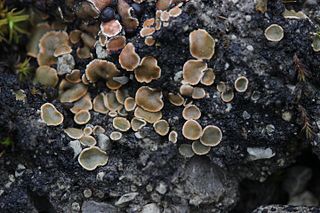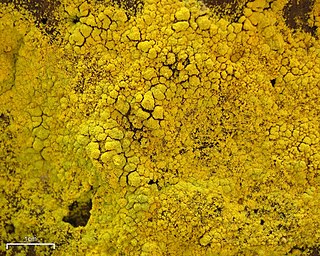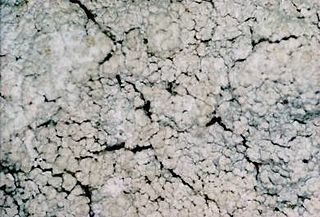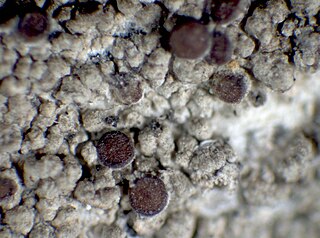
Psora is a genus of lichen-forming fungi in the family Psoraceae. Members of the genus are commonly called fishscale lichens. Lichens in the genus Psora generally have a squamulose thallus and anthraquinones in the hymenium. Photobiont partners of Psora lichens include members of the green algal genera Asterochloris, Chloroidium, Myrmecia, and Trebouxia.

Chrysothrix candelaris, commonly known as the mustard powder lichen or gold dust lichen, is a species of leprose (powdery) lichen in the family Chrysothricaceae. It typically grows on tree bark, although it has also been recorded growing on rock. It does not show ascocarps or other reproductive structures, belonging to the group commonly known as the 'Fungi or lichens imperfecti' in the UK.

Lepraria is a genus of leprose (powdery) crustose lichens that grows on its substrate like patches of granular, caked up, mealy dust grains. Members of the genus are commonly called dust lichens. The main vegetative body (thallus) is made of patches of soredia. There are no known mechanisms for sexual reproduction, yet members of the genus continue to speciate. Some species can form marginal lobes and appear squamulose. Because of the morphological simplicity of the thallus and the absence of sexual structures, the composition of lichen products are important characters to distinguish between similar species in Lepraria.

Verseghya thysanophora, commonly known as the mapledust lichen, is a species of mostly corticolous (bark-dwelling), leprose lichen in the family Pertusariaceae. This common species is widely distributed in the Northern Hemisphere. The thallus of the lichen is a thin patchy layer of granular soredia, pale green to yellowish green in colour. The main characteristics of the lichen include the presence of lichen products known as thysanophora unknowns, and the conspicuous white, fibrous prothallus that encircles the thallus.

Chrysothrix chlorina, the sulphur dust lichen, is a species of leprose (powdery) crustose lichen in the family Chrysotrichaceae. Originally described scientifically by the Swedish lichenologist Erik Acharius over 200 years ago, it has been shuffled to many different genera in its taxonomic history before finally being transferred to Chrysothrix in 1981. The lichen has a circumboreal distribution, meaning it occurs in northern boreal regions across the planet. It is typically saxicolous (rock-dwelling), particularly on the underside of rock overhangs, but has in rare instances been recorded growing on bark and various other surfaces.
Chrysothrix tchupalensis is a little-known species of saxicolous (rock-dwelling), powdery lichen in the family Chrysotrichaceae. It occurs in north Queensland, Australia. The lichen forms a powdery, bright yellow thallus that grows on sheltered, humid rocks in a tropical rainforest environment.

Myochroidea is a genus of lichen-forming fungi of uncertain familial placement in the order Lecanorales. It has four species of grey or brown-grey crustose lichens.

Lepraria bergensis is an uncommon crustose lichen in the family Stereocaulaceae. It occurs in Northern and Central Europe, where it grows on siliceous (silicon-rich) rock walls, particularly under small overhangs, and on mosses on vertical to slightly sloping rock surfaces. The lichen thallus forms as a pale bluish-grey crust-like growth on rocks and mosses. The lichen begins as small, rounded patches a few millimetres wide, which may eventually coalesce into larger areas exceeding 1 centimetre in diameter. The thallus has a powdery texture, consisting of minute granules known as soredia and consoredia, which facilitate the lichen's asexual reproduction. The chemical composition of Lepraria bergensis is distinguished by the presence of several secondary metabolites: atranorin, rangiformic acid or jackinic acid, trace amounts of their respective derivatives, and a variety of anthraquinones. These chemical components cause the lichen to fluoresce a dull yellow under long-wave ultraviolet light.
Parallopsora is a small genus of lichen-forming fungi in the family Ramalinaceae. Established in 2018, the genus contains three species that were previously classified under a related genus, Phyllopsora. These lichens form small, scale-like growths that overlap like roof tiles and typically appear pale green to bluish-green in colour. They reproduce through both small brown fruiting bodies and sometimes through powdery structures on their surface. The species are known to grow in tropical rainforests, particularly in Brazil, Peru and Cuba.
Pseudolepraria is a fungal genus in the family Ramalinaceae. It comprises the single species Pseudolepraria stephaniana, a corticolous (bark-dwelling) leprose lichen found only in lowland tropical forests of Bolivia. First described as Lepraria stephaniana in 2010, the species was reclassified into its own genus in 2023 after molecular studies revealed its distinct phylogenetic position. The lichen is characterised by its thick, powdery, green-grey to creamy-white thallus lacking defined edges, and is notable for containing the rare compound 4-O-methylleprolomin. Unlike related Bolivian Lepraria species that occur at higher elevations, P. stephaniana is found only at altitudes between 300 and 470 metres above sea level in transitional zones between Chaco and Amazon rainforest types.
Namibialina is a fungal genus in the family Ramalinaceae. It comprises the single species Namibialina melanothrix, a fruticose lichen. The genus is endemic to the coastal deserts of southwestern Africa, from southern Angola to South Africa's Cape of Good Hope, where it grows on rocks, soil, or as an epiphyte on tree bark. It is characterized by its shrubby thallus with branching patterns that often end in blackish or hair-like projections, and by distinctive longitudinal grooves formed by cartilage-like tissue. The genus was circumscribed in 2020 based on molecular phylogenetic evidence showing it diverged from its sister genus Ramalina about 48 million years ago during the early Eocene.
Lepraria atlantica is a species of leprose lichen in the family Stereocaulaceae. Described as a new species in 2001, the lichen occurs in Australia, Europe, and Greenland, where it typically grows over rocks and associated mosses.
Lepraria celata is a species of leprose lichen in the family Stereocaulaceae. The powdery greyish-green lichen, described as a new species in 2006, occurs in eastern Europe.

Lepraria caesiella is a species of leprose lichen in the family Stereocaulaceae. It forms a thin, gray-blue powdery crust composed of granular aggregations and lacks a true cortex or lobes. The species is widespread throughout northeastern North America, occurring primarily on tree bark, especially hardwoods like oaks, though it can also be found on non-calcareous rocks in sheltered locations. It was formally described by Richard C. Harris in 2005 and is characterized by its production of atranorin, zeorin, and pallidic acid. phylogenetics studies have helped distinguish it from the morphologically similar L. harrisiana, which was previously considered part of the same species.
Leprocaulon coriense is a species of leprose lichen in the family Stereocaulaceae. It is found in Asia and Australia where it grows on various substrates, including rock, wood, bark, mosses and soil.
Lepraria cupressicola is a species of leprose lichen in the family Stereocaulaceae. It occurs in east and southeast Asia, where it grows on rocks, soil and bark in shaded, damp locations.
Lepraria eburnea is a widespread species of leprose lichen in the family Stereocaulaceae. It forms a powdery to cottony thallus that lacks clear boundaries and contains alectorialic acid as its main secondary metabolite. It grows on various substrates including rock, bark, and soil, showing a particular preference for calcareous materials in some regions. The lichen is found across Europe, North America, Australasia, and Greenland, occurring from sea level to alpine elevations, and is typically found in areas with high humidity. In North America, it is particularly abundant in the Great Lakes region and Maritime provinces of Canada, where it commonly grows as an epiphyte on tree bases in swampy areas.
Lepraria humida is a species of leprose lichen in the family Stereocaulaceae. Found in northern Europe and northeastern North America, it grows on siliceous rocks, often between mosses, typically on rain-sheltered damp surfaces.

Lepraria jackii is a species of leprose lichen in the family Stereocaulaceae, described by Tor Tønsberg in 1992. It forms a powdery thallus with variable colouration, ranging from pale green to straw-coloured, and grows on bark, mosses, wood, and rock surfaces in humid, sheltered environments. The species is characterised by its abundant soredia and distinctive secondary metabolites, including atranorin. Lepraria jackii has been recorded across Europe, North America, Asia, and Australia, preferring acidic substrates.
Lepraria leuckertiana is a species of leprose lichen in the family Stereocaulaceae. It occurs in Europe, North Africa, and South America, where it grows on bark and occasionally on soil in humid, open, well-lit places.








